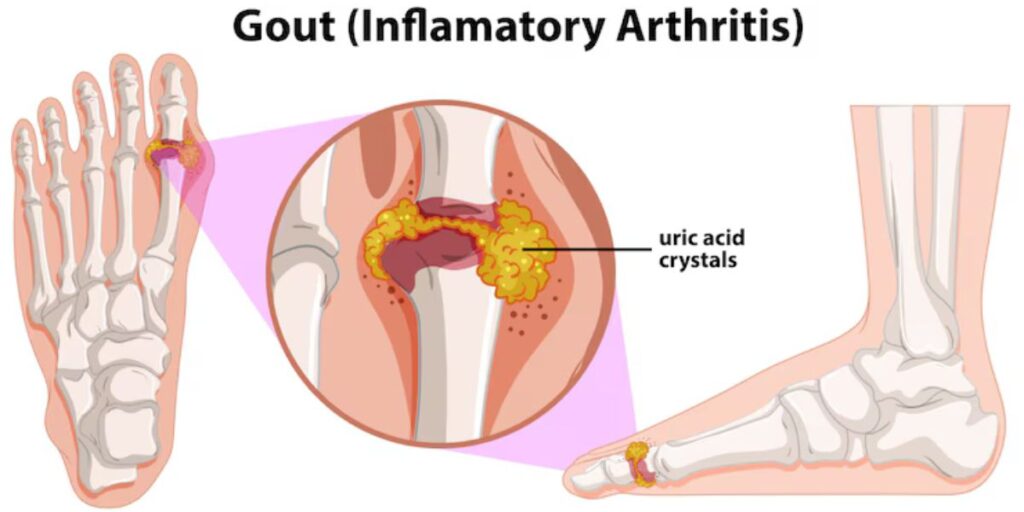Gout in foot is one of the most painful types of inflammatory arthritis. It usually starts suddenly, often at night, and affects the joint at the base of the big toe. This condition is caused by a uric acid buildup in the body. When too much uric acid forms sharp crystals in the joints, it leads to swelling, redness, and extreme pain. This intense pain is known as a gout flare-up, and the first joint hit is often called podagra. Without proper treatment, chronic gout can damage joints and reduce movement. Knowing the symptoms early helps avoid serious problems and manage future attacks more easily and effectively.
Overview
Gout is characterized by intense episodes of pain and swelling in the joints, particularly during the night. The pain can be so severe that even the weight of a bedsheet may seem unbearable. These flare-ups are caused by the accumulation of uric acid crystals in the joints, resulting from high levels of uric acid in the bloodstream. While gout is treatable, it requires ongoing management to prevent recurrent attacks and potential joint damage.
Symptoms
The hallmark symptom of gout is sudden, intense pain in a joint, often starting at night. The affected joint becomes swollen, red, and warm to the touch. Over time, if left untreated, gout can lead to joint deformities and the formation of tophi, which are deposits of uric acid crystals under the skin. These tophi can cause chronic pain and joint damage.
Causes
Gout occurs when the body produces too much uric acid or fails to eliminate enough through urine. This excess uric acid can form crystals that deposit in the joints. Factors contributing to gout include obesity, excessive alcohol consumption, high intake of purine-rich foods (like red meat and seafood), certain medications, and genetic predisposition.
Risk Factors
Several factors increase the risk of developing gout. These include being male, having a family history of gout, being overweight, consuming alcohol, especially beer, and eating foods high in purines. Additionally, certain medical conditions such as high blood pressure, diabetes, and kidney disease can elevate the risk.
Diagnosis and Tests
Diagnosing gout involves a combination of medical history review, physical examination, and laboratory tests. A joint fluid test, where a sample is taken from the affected joint and examined under a microscope, can confirm the presence of uric acid crystals. Blood tests measuring uric acid levels and imaging tests like ultrasound may also be used to diagnose gout.
Management and Treatment
Managing gout typically involves medications to reduce pain and inflammation during flare-ups and to lower uric acid levels in the blood. Nonsteroidal anti-inflammatory drugs (NSAIDs), colchicine, and corticosteroids are commonly used to treat acute attacks. Long-term medications such as allopurinol, febuxostat, and probenecid help prevent future gout episodes by lowering uric acid levels.
Gout Home Remedies
In addition to prescribed medications, certain home remedies can alleviate gout symptoms. Applying ice to the affected joint can reduce swelling and pain. Drinking plenty of water helps flush out uric acid, and consuming cherries has been suggested to lower uric acid levels. However, these remedies should complement, not replace, medical treatment.

Prevention
Preventing gout involves lifestyle changes aimed at reducing uric acid levels. These include maintaining a healthy weight, limiting alcohol intake, avoiding purine-rich foods, staying hydrated, and exercising regularly. Medications may also be prescribed to lower uric acid levels and prevent future attacks.
Complications
If left untreated, gout can lead to severe complications. Chronic gout may cause permanent joint damage and deformities. The formation of tophi can lead to joint destruction and disability. Additionally, high uric acid levels increase the risk of kidney stones and may be associated with cardiovascular diseases.
Outlook / Prognosis
With proper treatment and lifestyle modifications, individuals with gout can manage the condition effectively. Most people experience fewer and less severe attacks over time. However, without treatment, gout can lead to joint damage and other serious health issues. Regular monitoring of uric acid levels and adherence to prescribed treatments are essential for long-term management.
Research and Education
Ongoing research continues to explore better ways to manage and treat gout. Studies focus on understanding the genetic factors contributing to uric acid buildup, developing more effective medications, and improving preventive strategies. Education about gout is vital to reduce stigma and encourage individuals to seek timely treatment.
Takeaway (Conclusion)
Gout is a manageable condition with appropriate treatment and lifestyle adjustments. Understanding its symptoms, causes, and preventive measures can help individuals lead a healthy life without the debilitating effects of gout. If you experience symptoms of gout, consult a healthcare provider for diagnosis and personalized treatment options.
Podiatrist vs Foot Doctor: Who Should You See for Foot Pain in the USA?
FAQs
How do I know if I have gout in my feet?
You may feel sudden, intense pain, swelling, and redness—usually in the big toe joint, often at night.
What are the 4 stages of gout?
The stages are: asymptomatic hyperuricemia, acute gout attack, intercritical gout (between attacks), and chronic tophaceous gout.
What food triggers gout?
Foods high in purines like red meat, organ meat, seafood, and alcohol (especially beer) can trigger gout attacks.
What causes gout in the foot?
Gout in the foot is caused by uric acid buildup, which forms crystals in the joints and leads to inflammation and pain.
Welcome to Heel Tooth! I’m Lee Marvin.

